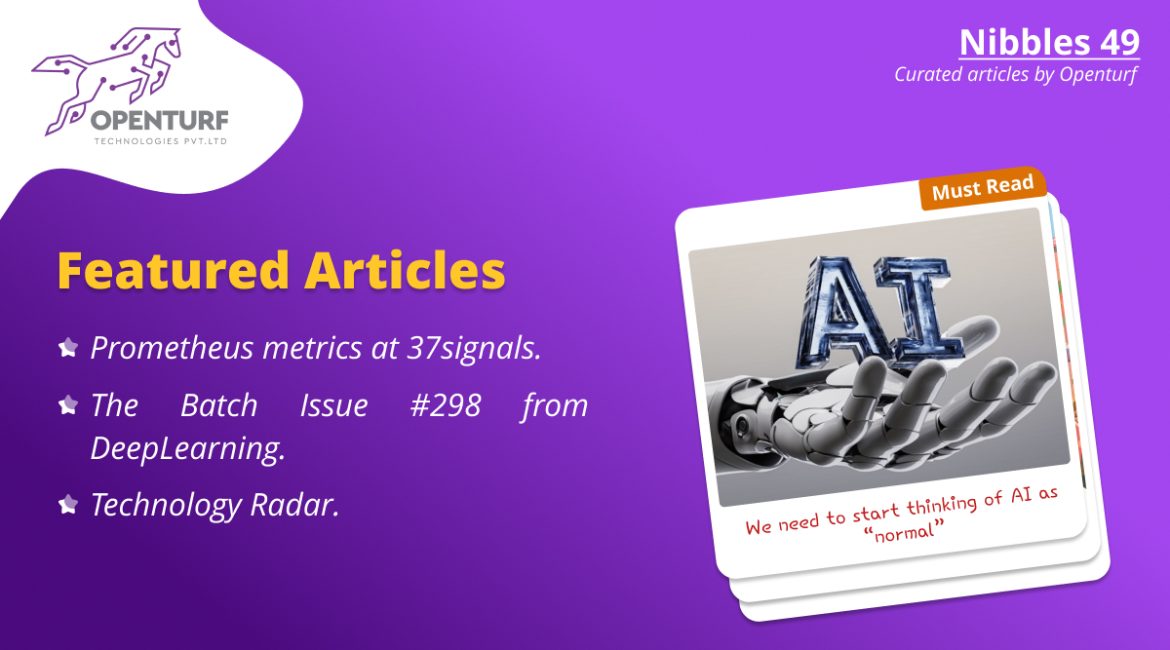The article “Is AI Normal?” from MIT Technology Review examines the polarized discourse surrounding artificial intelligence. While some experts, like OpenAI’s Sam Altman, envision AI’s impact as transformative as the Renaissance, public sentiment leans toward concern, with over half of Americans expressing apprehension about AI’s future. In contrast, Princeton researchers Arvind Narayanan and Sayash Kapoor advocate for viewing AI as a “normal” technology, akin to electricity or the internet, rather than a distinct, potentially dangerous entity. They argue that AI is a general-purpose technology whose integration into society should be approached with measured optimism and critical oversight, rather than fear or hype.
For a comprehensive understanding, you can read the full article here: Is AI Normal?
Prometheus metrics at 37signals
The article “Prometheus metrics at 37signals” from the 37signals Dev blog details how the company employs Prometheus for observability in its on-premises infrastructure. The Ops team at 37signals migrated applications from the cloud back to their own data centers, necessitating robust monitoring solutions. Prometheus, an open-source monitoring tool, was chosen for its time-series data storage capabilities and its query language, PromQL. The team utilizes Prometheus to ingest, store, and alert based on metrics, ensuring they can confidently manage infrastructure and applications on-premises. The article provides insights into the architecture, metrics generation, and operational practices involved in their Prometheus setup.
For a comprehensive understanding, you can read the full article here: Prometheus metrics at 37signals
The Batch Issue #298 from DeepLearning.AI covers key AI developments, including:
- OpenAI’s New Models: Introduction of five new models (GPT-4.1 series), excelling in benchmarks and multimodal reasoning.
Hugging Face’s Open Robot: A new open-source robotics framework to foster innovation. - U.S. AI Chip Regulations: New U.S. export controls on advanced AI chips, impacting global AI development.
- Multimodal LLMs: Advancements in text-only LLMs to handle multimodal inputs.
Read the full issue here: The Batch Issue #298
Technology Radar
The Thoughtworks Technology Radar Vol. 32, published in April 2025, offers a comprehensive overview of emerging technologies shaping the software development landscape. This edition highlights the pervasive influence of Generative AI (GenAI) across various facets of software engineering, from coding assistants to data management.
Key Highlights:
- Generative AI in Software Development: The Radar identifies 48 AI-related technologies, emphasizing tools like AI-assisted coding assistants and software engineering agents. These tools are designed to enhance developer productivity by automating code generation and error correction, though they recommend maintaining human oversight to ensure quality and accuracy. ThoughtWorks
- Evolving Observability Practices: With the increasing complexity of distributed systems, there’s a shift towards advanced observability techniques. The adoption of OpenTelemetry and the development of Large Language Model (LLM)-based observability tools are highlighted as significant trends in monitoring and maintaining system health. ThoughtWorks
- Data Product Thinking: The Radar advocates for treating data as a product, emphasizing the importance of clear lifecycle management, quality standards, and user-centric design in data handling practices. ThoughtWorks
- Advanced Retrieval Techniques in GenAI: Innovations like Corrective RAG, Fusion-RAG, and Self-RAG are introduced to optimize the retrieval process in Retrieval Augmented Generation systems, aiming to improve the relevance and accuracy of AI-generated responses. ThoughtWorks
For a detailed exploration of these trends and more, visit the Thoughtworks Technology Radar Vol. 32
Fun Stuff
Our usual fun stuff





